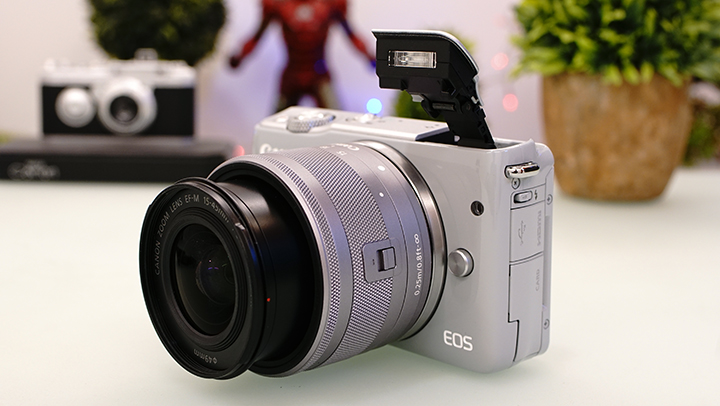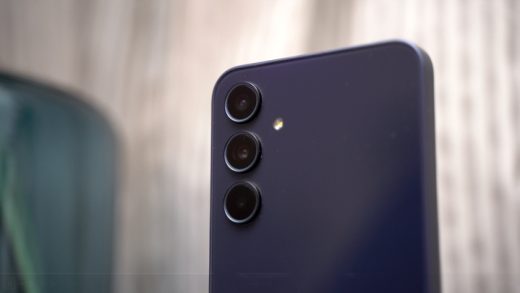The Canon EOS M10 came as the stripped-down version of the company’s EOS M3. It lacks the 24MP shooter but settles for a decent 18MP CMOS sensor. It’s also missing an electronic viewfinder and sports a simpler body compared to its sibling but let’s see what this compact camera can offer with an asking price of less than Php21K.
Table of Contents
Design and Construction

Carrying an all-plastic body, the EOS M10 has a glossy finish that blends well with its color. There’s black and white available but the unit that Canon lent us is the gray variant. It does look more consumer-friendly than a professional tool since it’s exactly whom this camera is designed for.

Up top, we have the main buttons and dials. There’s the main power switch inside the mode selection ring that toggles between Video Recording, Camera, and Intelligent Auto modes. Just beside it is the shutter button — again, trapped inside the adjustment ring for adjusting the ISO, shutter speed, among others. Finally, we have the video record button at the farthest right edge.

Over here, we see the rest of the buttons for menu and tweaking other settings like exposure and white balance. There’s also a strip of rubber with an embossed grip to aid when holding the camera while shooting. It does help, but for a guy with big hands such as me, the camera felt a bit too small.

On the left side are where the miniUSB, mini HDMI, and miniSD cards are all hidden under a plastic flap and above them is the toggle to get the built-in flash to pop out.

The area on the top left is where the flash comes out. This is the same implementation Canon did with the EOS M3 and we actually like it since it makes the camera a little more neat and compact.

Its 1.04M-dot display tilts all the way up to 180 degrees and makes it easy for users to take a selfie. The hinge only goes one way, though, and doesn’t tilt the other way around unlike the M3.
Canon says the M10 has an approximate weight of 301 grams with the battery and without any lenses attached to it. We weighed it ourselves and it clocked in at 312 grams which came in pretty close to their claims. Aside from it being a little too small for my huge hands, it is definitely light enough to have inside a bag all the time.
Display
Its tilting display is also a touchscreen which means you can modify your settings with just a few taps. During our experience, it was a mix of selecting the settings using the display and adjusting its value (for example ISO or shutter speed) using the selection wheel.

Images shown have a decent amount of details with good contrast. Viewing angles are accommodating and outdoor glare has been kept to a minimum so that’s good news. The hinges also feel sturdy when you flip it and doesn’t wobble.
Performance
We’ve used the EOS M10 for about a week and shooting with it is simple and straightforward. It powers up fast and is ready to capture in less than 5 seconds so that’s a good thing. The unit we have comes with an EF-M15-45 mm f/3.5-6.3 IS STM lens but is just one of the three available bundles.

The included 15-45mm lens is a decent partner for the M10 as it doesn’t add that much weight but offers its users a considerably wide range of depth of field for achieving a variety of shots. To set it up, it needs to be put in shooting mode by pushing the lock forward and twisting the lens.

Additionally, the camera automatically switches to selfie mode when you flip the display 180 degrees — a simple yet efficient feature Canon has added in.

The M10 carries the company’s hybrid CMOS AF II which is also present in their 100D. This makes it possible to perform a snappy focus at the shortest time possible even when in Live View. Plus, it also has tracking focus that keeps the focus on a subject of your choosing. This greatly helps when shooting videos to make sure your shots are focused even when you pan sideways or dolly in and out.
Image Quality
Images produced by the M10 are satisfactory at best. Colors are natural and have pleasing vibrance although details left us wanting a bit more.
Photos have good brightness and contrast is not overly-done, but artifacts can already be seen even though ISO was kept to a conservative setting (ISO 200 or so).
We also had issues with its Auto White Balance since it seemed like it was having a hard time determining the right color for the scene so we ended up having a series of photos with different WB settings. Check out its sample images.
Check out the low light performance of the M10 on all its available ISO range (100, 200, 400, 800, 1600, 3200, 6400, and 12800).
- ISO 100
- ISO 200
- ISO 400
- ISO 800
- ISO 1600
- ISO 3200
- ISO 6400
- ISO 12800
Video quality is also decent and looks less grainy than others in its class. Although, resolution maxes out at Full HD and there’s no 4K shooting using the M10.
Battery Life
Using its 875mAh (6.3WH) rechargeable Li-Ion battery, we were able to last for about 4 days of light to medium shooting of about 2-3 hours per day. At this rate of battery performance, it’s a good travel buddy to document your vacations without having to worry about charging all the time.
Conclusion
The Canon EOS M10 delivers a light and compact body which can be easily stored inside a small bag. Although plastic, the shell doesn’t feel cheap and is quite solid when you hold the device. Operating and changing its settings are simple and even casual users won’t have a hard time figuring it out.

We liked its tilting display for easy selfies, and its hybrid autofocus with auto tracking keeps subjects focused. Images didn’t turn out to have the best details we’ve seen around, but is understandable since the M10 targetted to those who want a no-fuss point and shoot camera that carries capable internals for all around casual shooting.
As mentioned earlier, the EOS M10 comes in three lens kit bundles. First is with an EF-M15-45 mm f/3.5-6.3 IS STM lens for Php20,998. The second bundle will have an additional EF-M55-200mm f/4.5-6.3 IS STM lens for Php32,498. The third will give the option of having the first lens kit plus an EF-M22mm f/2 STM pancake lens.
Canon EOS M10 specs:
180-degree tilt type touch screen, approx. 1.04 million dots
18MP APS-C CMOS sensor
DIGIC 6 image processor
Hybrid CMOS AutoFocus II
100-12,800 ISO (expandable to 25,600)
Up to 1/4000th of a second shutter speed
4.6 fps continuous shooting
1920 x 1080 video recording
Wi-Fi
NFC
108 x 66.6 x 35mm
Approx. 301 grams
875mAh (6.3WH) Li-Ion battery
What we liked about it:
- Light body
- Simple and straightforward operation
- Tilting display
- Snappy autofocus
- Tracking focus is present
- Commendable battery life
- A simple, all-around casual shooter
What we didn’t like:
- Could be a bit too small for users with big hands
- Digital noise easily comes out even on low ISO
- AWB is a hit and miss









































